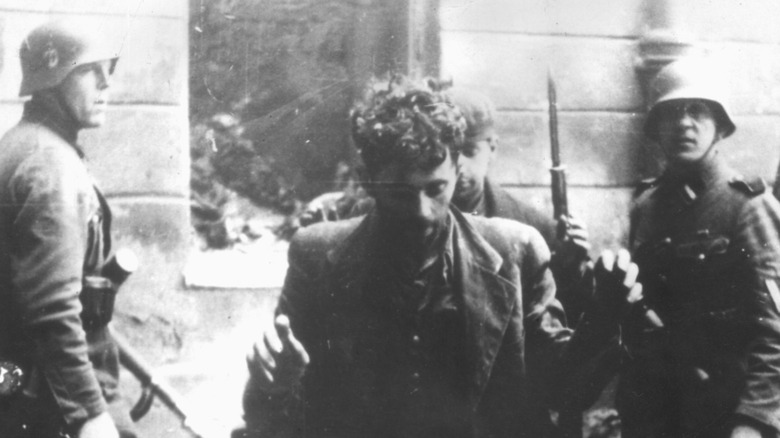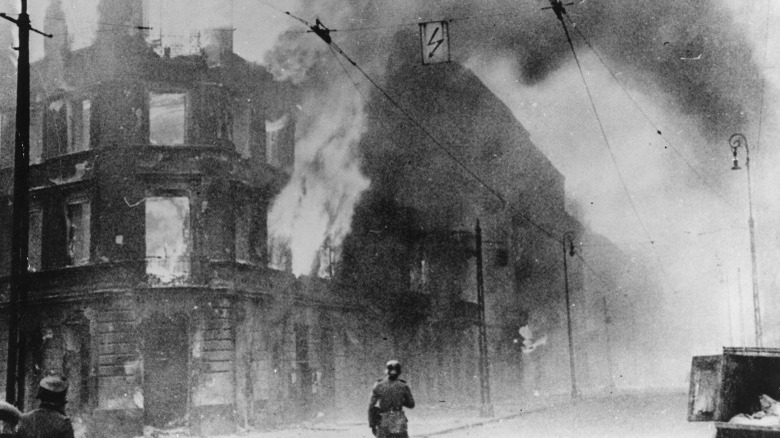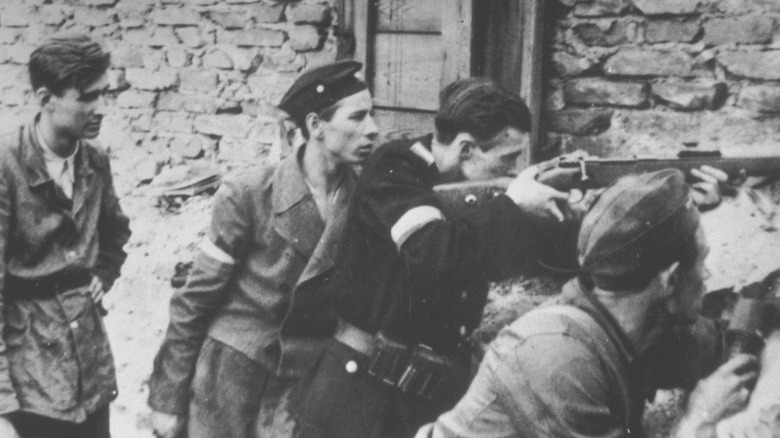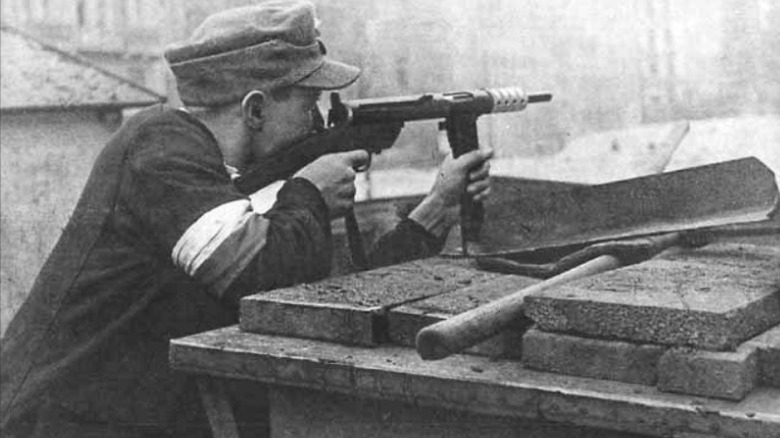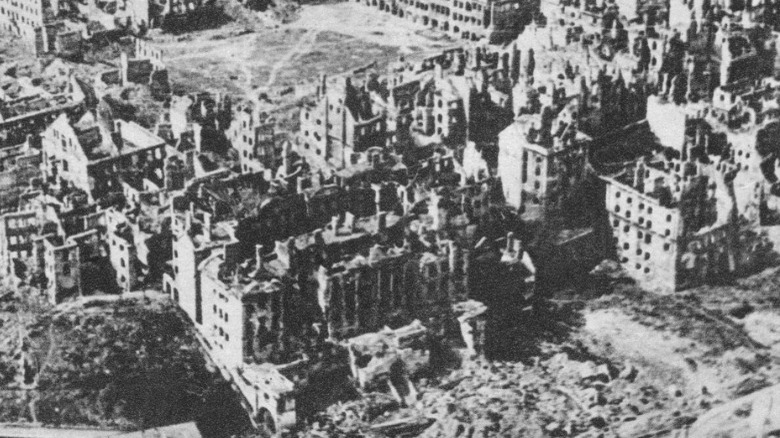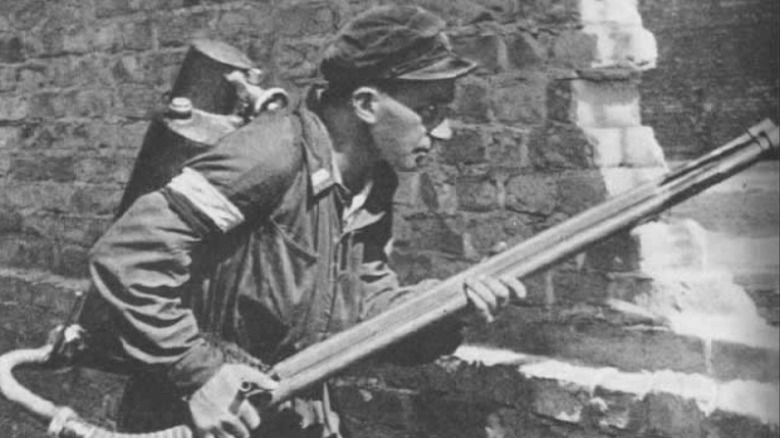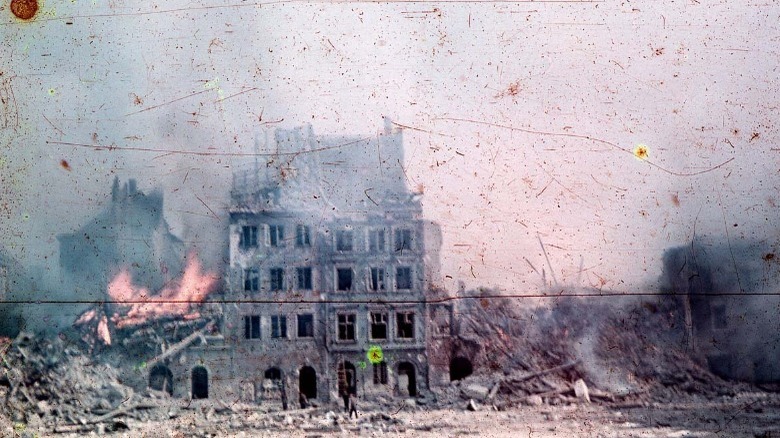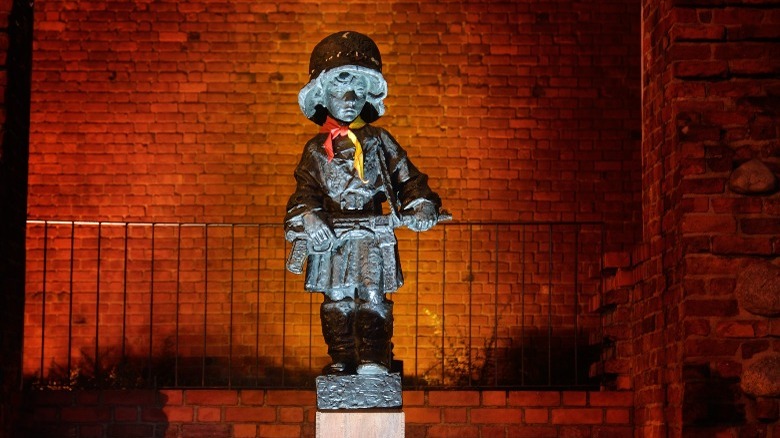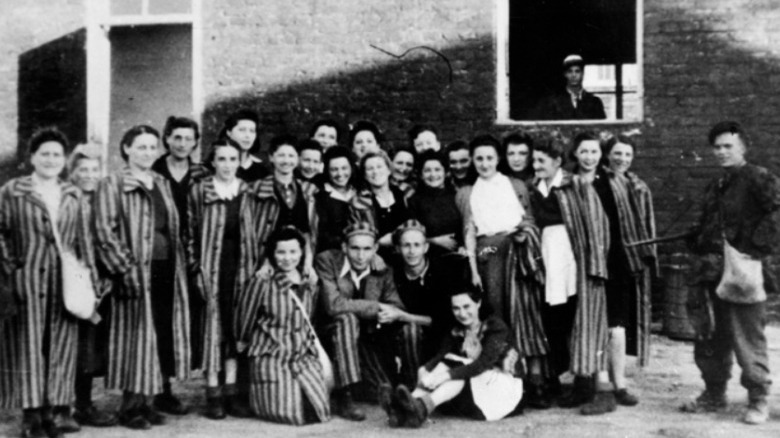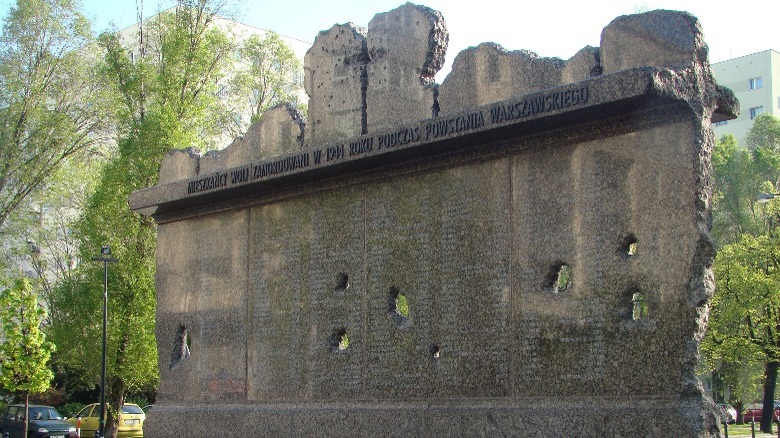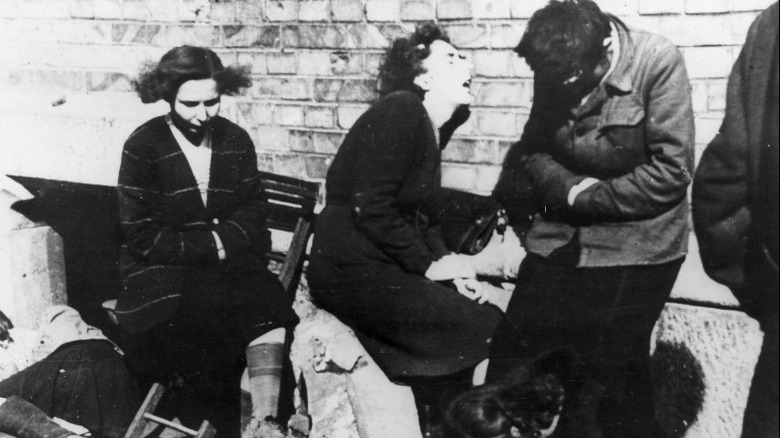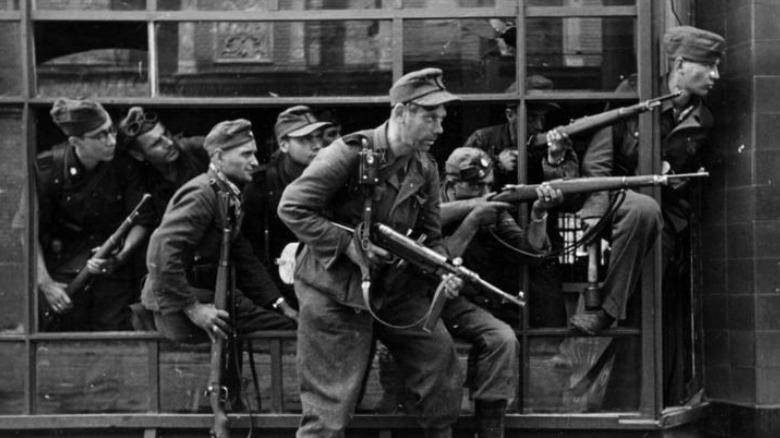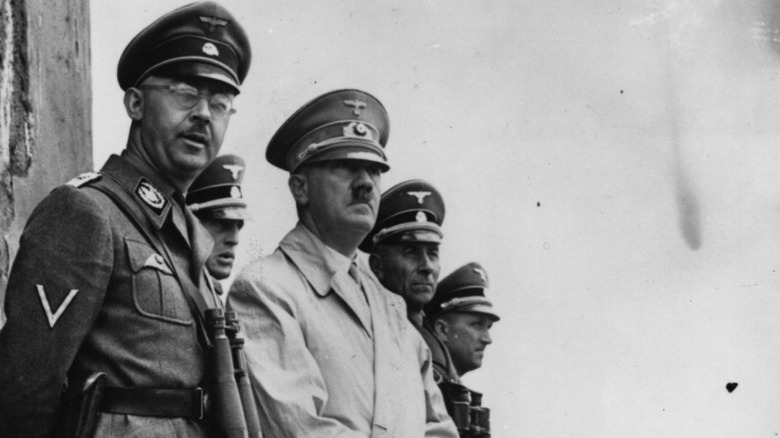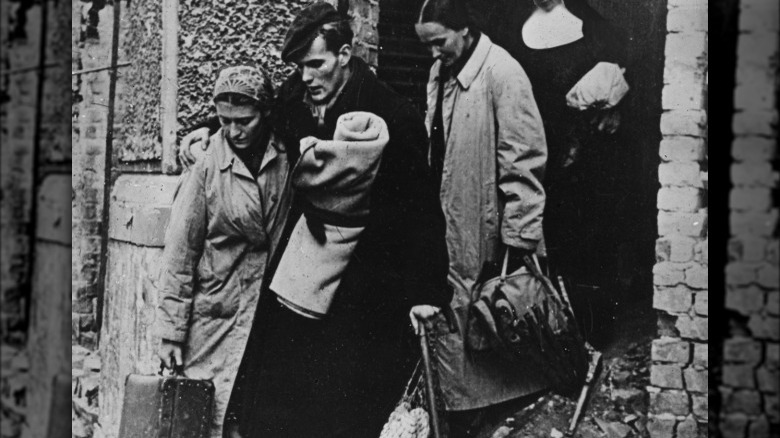Tragic Details About The Warsaw Uprising
World War II was one of the most devastating events in modern history. Millions of combatants fought each other on the battlefields of Europe and the Pacific front, killing one another in a blood-soaked orgy of rage and violence. According to History, as many as 80 million people died during the war. Roughly ⅓ of the deaths were in the military, but the other ⅔ were innocent civilians, simply caught up in the ravages of an incredibly destructive war. The war began in 1939, following German Fuhrer Adolf Hitler's invasion of Poland, and ended six years later after his death and the atomic bombing of Japan.
One of the most tragic footnotes of the entire war was the harrowing and ill-fated Warsaw Uprising by the Polish Home Army against the Nazis in Warsaw, Poland. The siege lasted for just over two months, as Polish rebels in the city fought against their Nazi overlords. In the end, the Nazis defeated the lightly armed Poles, and resumed their occupation in an especially brutal fashion. Though it happened nearly 80 years ago, it is still an immensely important part of history. These are tragic details about the Warsaw Uprising.
Warsaw was already under a horrifying occupation
The Warsaw Uprising first broke out in late 1944, but the city had already been under occupation for several years by that point. As Dr. Alexandra Richie explained during an interview with the National WWII Museum, Adolf Hitler and two million Nazi soldiers had initially invaded Poland in September 1939. They immediately took control of the city, rounding up various Polish and Jewish residents and murdering many of them.
According to Dr. Richie, Hitler viewed both Jewish and Polish people as "racially inferior" to Germans, and he wanted to cleanse Europe of both their populations. The outgunned and outmanned Polish army was barely able to mount a resistance and quickly fell apart along with the city. A wave of Nazi terror swept through Warsaw as thousands of civilians were ruthlessly executed, and many were sent to prisons and concentration camps.
While the native inhabitants lived in fear and degradation, the Nazi occupiers converted Warsaw into a luxurious garrison town. They misappropriated property from residents, especially Jewish ones, and also took over the city's banks and businesses. In 1943, there was an uprising in the Jewish Warsaw Ghetto, but it was quickly put down. Life inside Warsaw was nothing short of hell during the Nazi occupation for the residents, creating an atmosphere for rebellion.
It was part of a larger failed operation
The Warsaw Uprising was not an isolated battle and was actually part of a much larger strategy by the Polish Home Army. According to the National WWII Museum, the strategy was officially called Operation Tempest and was supposed to culminate with the Nazi eviction from Poland. It was also designed to help prevent the Soviet Union's military and political takeover of Poland following the German collapse, something the Polish Home Army desperately feared.
Initially, Warsaw was not supposed to be part of Tempest. Tempest's planners deemed the city — Poland's capital — to be too important and too populated to risk total destruction. However, as per Dr. Alexandra Richie, it was added to the battle plans just before the uprising occurred in the summer of 1944. The combination of the Soviet's successful Operation Bagration, the failed July 20 plot that inspired "Valkyrie," and the mistaken belief that the Red Army was on its way into the city, led the planners to include Warsaw at the very last minute — literally days before the uprising began.
Operation Tempest started in March 1944, and the Polish Home Army fought with the Red Army to liberate several towns. However, Soviet Union Generalissimo Joseph Stalin did not trust the Home Army, and ordered his secret police, the NKVD, to disarm and arrest them following liberations, depriving them of their victories. Operation Tempest ultimately failed with the suppression of the Warsaw Uprising, ending another tragic chapter for Poland during WWII.
The uprising was started by mistake
When Polish Home Army planners added Warsaw to the list of cities for Operation Tempest, they knew that they would need help to ultimately be victorious. That's why, according to Dr. Alexandra Richie, they timed it to coincide with the Soviet Union's offensive known as Operation Bagration. Bagration started in the summer and had been very successful through July. However, the German army under Walter Model launched a successful counterattack at the end of the month, which temporarily halted the Soviet advance.
Unaware of Model's attack, the Polish Home Army mistook the sounds of his troops fighting as the sound of the incoming Soviets, who they thought were in the process of smashing the Germans. Given even more incorrect information that the Red Army was on the outskirts of the town, Polish Underground General Bar-Komorowski ordered the uprising to begin on August 1, 1944.
The uprising commenced under false pretenses, and it quickly spelled disaster for the Home Army. The Soviets were bogged down by Model and did not enter the city, leaving the Home Army to face the Wehrmacht by themselves. In addition, the Red Army did not provide any artillery or air support, and Soviet leader Joseph Stalin stopped the British and Americans from using his airfields to airdrop supplies to the beleaguered Poles (via the National WWII Museum).
Warsaw was slowly destroyed
Throughout the two-month siege and battle, the city of Warsaw was slowly reduced to ruins. One resident of the city, Miron Białoszewski, described its thorough destruction in his book "A Memoir of the Warsaw Uprising." According to Białoszewski, there were countless German attacks against areas of the city that were being defended by Home Army soldiers. The city began to deteriorate in the face of constant fires and buildings collapsing, and incessant German bombing kept creating new fires throughout the city. The residents were unable to contain all of the blazes.
Houses were destroyed and the streets were littered with dead and dying bodies. The German bombing, in addition to starting huge fires, also left massive craters that pockmarked the Warsaw streets. During their attacks, the German army would use tanks to obliterate buildings and potential defenses in the city, before having troops move in to mop up the remaining resistance (per Alexandra Richie's "Warsaw 1944: The Fateful Uprising").
As the battle continued, the city succumbed to further degradation. The constant bombs, grenades, mines, and tanks demolished everything in their path, and the historic Old Town was completely leveled. Eventually, the Germans started using flamethrowers to burn everything to the ground.
The Home Army struggled to care for its wounded
As the fighting in Warsaw raged, the casualties started to pile up for both sides. However, things were undeniably worse for the Polish Home Army, who were being constantly pushed back. Quickly, the medical personnel became overwhelmed by the huge task before them. As Dr. Alexandra Richie explains in "Warsaw 1944," within a few weeks of fighting the doctors were already hopelessly inundated with casualties. There were barely 30 qualified medical personnel to handle upwards of 6,000 patients, making roughly one doctor available for every 200 patients.
The conditions they had to work under were horrendous, and they had to import supplies through the sewer system. There was not nearly enough space for the growing number of injured, and patients were succumbing to wounds everywhere. Hygiene was basically non-existent under the conditions, and they did not even have anesthetics for those undergoing surgery. They had to substitute red wine for potable drinking water, and people could barely stop from slipping and falling on the floors that were pooled with blood.
Infections began to skyrocket and vermin started to gnaw on the various amputated body parts hastily thrown in buckets. Blankets and mattresses were substituted for stretchers, and injuries ranged from bullet wounds to cuts from shrapnel to blindness and bone fractures.
For some soldiers, this was their second Warsaw Uprising
As soon as Hitler's armies invaded Poland in 1939, the Jewish population living there was immediately placed in heightened danger. According to Dr. Alexandra Richie, many Jewish residents were summarily murdered by Nazis in the Palmiry Forest, and thousands were sent to concentration camps like Auschwitz. The 400,000 who weren't murdered or sent to camps were confined to a tiny area of the city, which became known as the Warsaw Ghetto (per History).
In 1943, after years of slow strangulation and after most of the ghetto had already been deported to camps, Jewish resistance fighters tried to fight back against the Germans during the Warsaw Ghetto Uprising. Yet, they were badly outnumbered and easily defeated within a month. Most of the resistors were either killed or sent to concentration camps, but a few survived in Warsaw more than a year later to be on hand for the Warsaw Uprising of 1944.
According to the National WWII Museum, some of these veterans also participated in the 1944 Warsaw Uprising, fighting the Nazis in combat once again. Barred from fighting with the majority of Home Army units due to antisemitism, Jewish fighters joined the alternative Socialist People's Army, which was for the most part much more lenient. The Jewish fighters fought valiantly for their neighbors and their country, even if not all of their comrades respected them as equals.
Children fought for the Home Army
One of the saddest and most heart-wrenching details about the Warsaw Uprising is the use of child soldiers by the Polish Home Army. They were known as the Szare Szeregie, or Grey Ranks, which was originally a youth movement similar to the American boy scouts (via Norman Davies' "Rising '44: The Battle for Warsaw"). As soon as the war broke out in 1939, kids as young as 12 and 13 begged to be allowed in the Grey Ranks, and thus joined the Polish underground resistance.
There were several Grey Ranks groups that participated, including the Parasol and Zoska battalions. According to the National WWII Museum, children 14 and younger were used as messengers, porters, and in intelligence work, often crawling through sewers and rubble to deliver important information. Those 15 and older actively served in combat units during the Warsaw Uprising, and those 17 and older were reportedly among the best in the entire Polish Home Army.
Following the war, a statue known as Mały Powstaniec (the Little Insurgent), was designed by Jerzy Januskiewicz and installed in Warsaw. The monument is an homage to the child soldiers of the uprising and has a young girl carrying a machine gun, and wearing an oversized helmet meant for an adult.
Jewish prisoners were nearly massacred
Inside Warsaw in what was left of the former Ghetto stood the Gęsiówka concentration camp. Most of the Jewish prisoners had already been sent to the Dachau labor camp, but there were still a few kept around when the uprising began (via Dr. Alexadra Richie in "Warsaw 1944"). The Schutzstaffel (SS) guards manning the few remaining prisoners became worried when it broke out, and soon it appeared as if they were going to murder the remaining prisoners before anything could be done to save them.
However, the Polish Zoska battalion was able to mount a raid on the camp and liberated the embattled prisoners on August 5, 1944. The prisoners were overwhelmed when they saw their liberators, who they first mistook for more Germans upon seeing their uniforms. Incredibly, many of the prisoners immediately volunteered themselves for duty, and several of them started fighting in the Home Army.
They were used in combat roles to fight the Nazis, and many of them died in defense of Warsaw. There was even a Jewish battalion consisting of former Gęsiówka concentration camp inmates, who fought alongside their liberators in the Zoska Battalion.
Many civilians were killed during the fighting
The intense fighting in the city was a harrowing ordeal for everyone involved, including innocent civilians. As the National WWII Museum explains, the Polish Home Army did not tell many of the inhabitants of Warsaw about the uprising before it began, leaving many of them inside the city once the firing erupted. Some people were caught at work and became trapped inside Warsaw, unable to leave to reunite with their loved ones. Others had the opposite experience, where parents were trapped outside of the city with no access to their children inside the boundary lines.
Many people were killed just walking across the street, and there was so much chaos and a lack of available medical personnel that many of them were simply left there. According to the Hoover Institution, an estimated 150,000 civilians were killed during the fighting in Warsaw.
Not all of the civilian deaths were accidental, as the horrific Wola Massacre showed. According to Dr. Alexandra Richie in "Warsaw 1944," German soldiers deliberately rooted out and systematically murdered the residents of Warsaw's Wola district. The operation was led by SS General Heinz Reinefarth, and he ordered his troops to kill everyone, including women and children. They even targeted hospitals, and the Hoover Institution estimates that 40,000 people were killed in just two days in Wola.
There were massive casualties for both armies
The Warsaw Uprising took a devastating toll on both the German and Polish sides. The Polish forces consisted of multiple armies, including the Home Army, National Armed Forces, and the communist People's Army (via the Holocaust Encyclopedia). There were barely more than 45,000 soldiers on the Polish side, and the majority of them were unarmed due to a weapons shortage. On the other side, the German Wehrmacht initially had 25,000 soldiers, but they also had the ability to bomb, use artillery, and send in many tanks.
The Germans took over 11,000 prisoners of war, and they also killed nearly 15,000 Polish rebels during the fighting (via Britannica). The Polish forces killed roughly 16,000 Germans, an incredible number considering the massive odds they were facing. However, while the Germans lived to fight another day, the Polish forces were effectively destroyed following the failure at Warsaw. This allowed the Soviet Union's Red Army to take control of Warsaw and the rest of Poland just a few months later. The Soviets then installed a friendly communist government to take over the exiled Polish government in London.
The Home Army quickly lost support
The entire Warsaw Uprising lasted for 63 long days, from August 1 to October 2, 1944. While civilians were not informed beforehand about the uprising, when it erupted on the first of the month, there was widespread support for the Polish forces (per the National WWII Museum). They were under the impression the fighting would be short-lived and the Red Army would soon arrive to help finally vanquish the Nazis. After chafing under Nazi oppression for five years, the civilians were more than ready to finally be free again.
However, when the Red Army did not show up and the Polish forces started to lose ground, they also started to lose civilian support. When fighting first broke out, part of the population could be counted on to help get supplies, throw Molotov cocktails, and build barricades. Yet, once the Germans regrouped and launched their counter-attack, Warsaw quickly became embroiled in chaos, and the civilians became demoralized.
The uprising reached a high water mark on August 5, after a few victories and following an airlift of supplies from the British (per Alexandra Richie's "Warsaw 1944"). Unfortunately, pretty much everything from then on was downhill for the Poles, who were slowly squeezed to dust over the next two months.
Hitler ordered everyone in Warsaw to be killed
Among the never-ending list of horrifying and detestable things German Fuhrer Adolf Hitler did, his actions during the Warsaw Uprising are still among the most heinous and despicable. As Alexandra Richie explained in "Warsaw 1944," The day the uprising began, Hitler and his close aide Heinrich Himmler were already made aware back in Germany. In response, they issued the Order for Warsaw, which explicitly called for the murder of every citizen in the city, regardless of if they were women, children, or soldiers.
They wanted to use Warsaw as an example for anyone else thinking of rebelling against the Nazi war machine. Initially, they considered using the Warsaw residents as slave laborers, especially the women, but that all changed the day the uprising began. Soldiers were forbidden from taking any prisoners of war and instead were directed to murder them in cold blood — a clear war crime.
Eventually, Hitler wanted to create "Himmler Park" on the ruins of Warsaw. The order was so horrible, that most German commanders refused to acknowledge that the entire Warsaw Uprising had taken place in their postwar memoirs. In creating the order, Hitler and Himmler were largely fueled by their racial hatred for the Polish and Jewish residents. In a chilling coincidence, on August 4, 1944 during the early days of the rebellion, the Germans captured Anne Frank, which turned out to be an ominous sign of the fate of Warsaw.
The survivors were sent to concentration camps
Despite German Fuhrer Adolf Hitler's order for everyone to be murdered, there were still hundreds of thousands of Polish civilians in Warsaw by the time the uprising ended. As Alexandra Richie explains in "Warsaw 1944," Hitler wanted to use the remaining population as slave laborers. They created a transit camp in Warsaw known as Pruszków and immediately started piling in residents within days. Following the siege, 55,000 of the camp's inhabitants were deported to concentration camps.
In all, 650,000 civilians were taken from Warsaw and sent to Pruszków, where many of them ended up perishing (via the National WWII Museum). Still, the Germans were not able to capture or kill all of the residents of Warsaw, and there were many who evaded capture and stayed behind. They were known as the "Robinsons," named after Robinson Crusoe, a fictional English hero.
Though their name may have been glamorous, their lives were anything but. In the war's aftermath, Robinsons had to survive under extreme conditions, and many of them were Jewish residents who feared murder and extermination at the hand of the Nazis. They lived in the ruins of buildings and the sewers, fearful of any exposure to the German army. Only a fraction of them survived to the end of the war, with the rest falling casualties to Hitler's vicious war machine.
